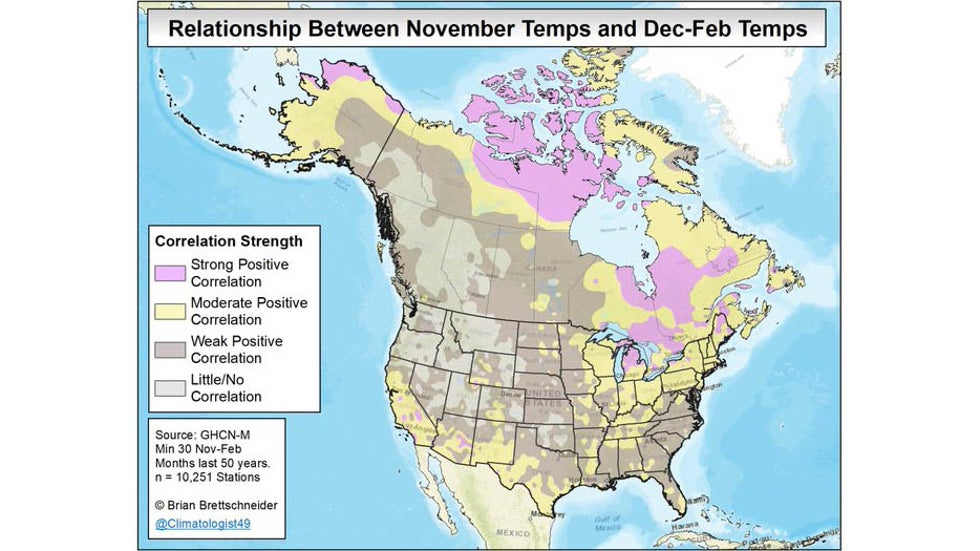The first half of November has been dominated by record-shattering arctic blasts in the central and eastern United States, but does a cold November give any indication of how temperatures will be in December, January and February?
According to research by Dr. Brian Brettschneider, climatologist at the University of Alaska Fairbanks, the answer is yes.
Brettschneider compiled the map below, which illustrates the relationship between November temperatures and December to February temperatures.
Areas in yellow or light purple have a moderate to strong relationship, meaning colder than average Novembers tend to be followed by colder than average winters and warmer than average Novembers tend to be followed by warmer than average winters (positive correlations).

Moderate to strong relationships exist across parts of the upper Midwest, Great Lakes, Ohio Valley, Tennessee Valley and Northeast, Brettschneider's map shows.
As residents of those regions are well aware, November has been quite cold so far, and hundreds of additional record-cold temperatures for mid-November are in jeopardy through Thursday.
The first 11 days of this month were among the 10 coldest Nov. 1-11 periods on record in several cities east of the Rockies, according to the Southeast Regional Climate Center. This includes Chicago (third coldest), Detroit (sixth coldest), Little Rock, Arkansas (sixth coldest), Minneapolis-St. Paul (sixth coldest), Buffalo, New York (seventh coldest), Pittsburgh (seventh coldest) and Cincinnati (eighth coldest).
Much of California and southern portions of Arizona, New Mexico and Texas are other places that have moderate to strong relationships between November temperatures and December to February temperatures. In general, those areas have been near or slightly above average so far in November.
The rest of the country – including most of the Great Plains and Rockies – doesn't have much of a correlation between temperatures in November and those during the heart of winter.
So will the Midwest and Northeast remain colder than average this winter while the West and Southwest stay relatively mild? Brettschneider's research says that's more likely than not to be the case, based on temperatures averaged over many years.
Dr. Todd Crawford, chief meteorologist at The Weather Company, an IBM Business, agrees with Brettschneider.
"There is pretty good evidence of correlation between November patterns and December to February aggregate patterns, both via temperature correlations and via correlations between various teleconnections, like the Arctic Oscillation and North Atlantic Oscillation," Crawford said in an email.
However, not every winter follows long-term averages, and there are many other factors at play in the atmosphere that can influence temperatures across the U.S.
An updated winter outlook from The Weather Company will be released Thursday on weather.com.
It should also be noted that there is "pretty much no relationship" between November snowfall and December to February snowfall, Brettschneider tweeted.
The Weather Company’s primary journalistic mission is to report on breaking weather news, the environment and the importance of science to our lives. This story does not necessarily represent the position of our parent company, IBM.

No comments:
Post a Comment